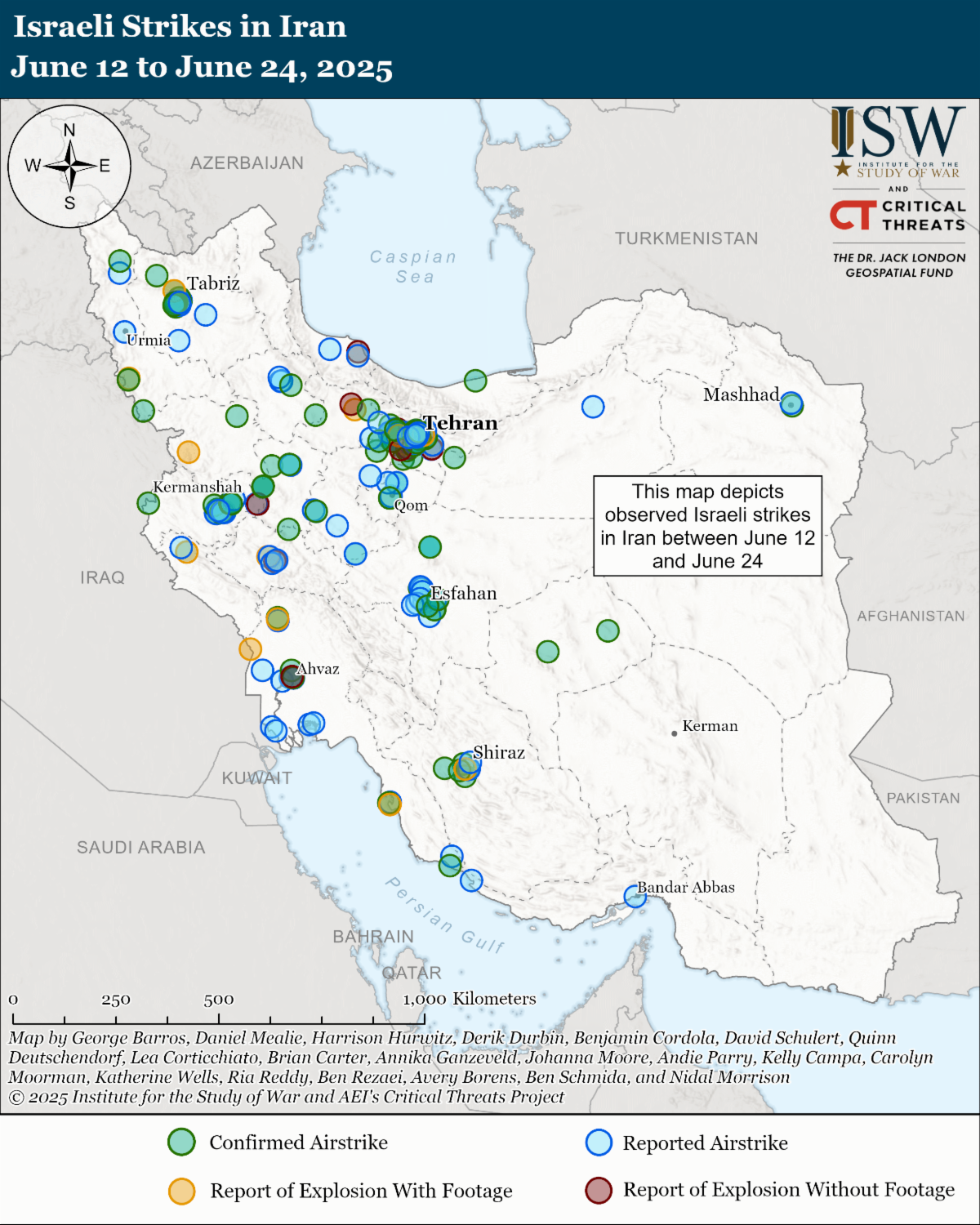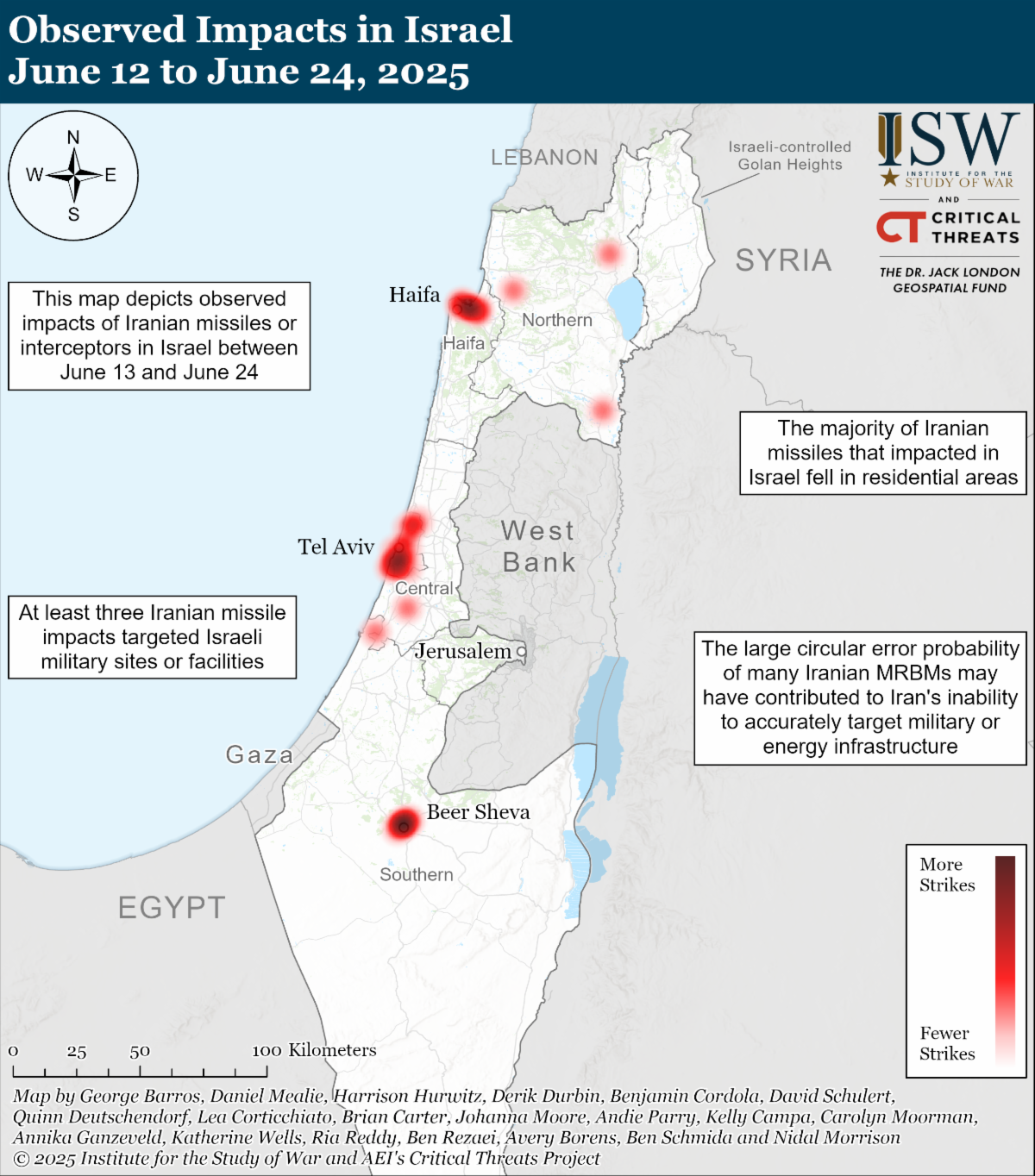Israel conducted a two-week air campaign with the objective of degrading, destroying and removing the threat of Iran’s nuclear program. Israel also pursued two supporting objectives to limit Iranian retaliation and provide itself with an offramp. Israeli Prime Minister Benjamin Netanyahu stated that “Operation Rising Lion” achieved all of Israel’s war aims “and much more.” Israel described Iran’s nuclear program as an existential threat to Israel and stated that it would not allow Iran to weaponize its program. Israel achieved its objectives vis-a-vis the nuclear program by destroying nuclear facilities and enrichment capacity with US support and killing key nuclear scientists who were instrumental in the development and weaponization of the program. The Israeli campaign, supported by US strikes, "effectively destroyed” Iran’s enrichment capacity, though stockpiles of various amounts of enriched uranium remain. Iran’s ability to enrich these to weapons grade uranium is complicated by the destruction of most of Iran’s centrifuges and the loss of many nuclear scientists. There is more information about the status of the nuclear program below.
Israel supported this main line of effort by conducting a campaign designed to prevent Iran from conducting effective retaliatory strikes on Israel by degrading its ballistic missile capabilities. Iran originally planned to launch 1,000 ballistic missiles in response to Israeli strikes on Iran, but Israeli strikes forced it to fire much fewer (more on the status of the missile forces below). Iranian ballistic missile strikes would have targeted Israeli military, intelligence, and political institutions that enabled Israeli operations. These strikes could have also caused major Israeli casualties, which would have been unacceptable for many Israelis. Israeli airstrikes on Iran’s ballistic missile program destroyed Iranian capabilities and forced Iran to launch fewer and smaller attacks on Israel, most of which were intercepted by the IDF.
Israel pursued a second supporting effort to compel Iran to accept a ceasefire on Israeli terms by creating the perception of a credible existential threat to the Iranian regime. Netanyahu and Israeli Defense Minister Katz directed the IDF on June 20 to “intensify” strikes on Iranian institutions that support regime stability. The Iranian regime has maintained social control by violently cracking down on protests and other expressions of popular anti-regime sentiment through internal security organizations. Israeli officials suggested that these airstrikes could create conditions which the Iranian population could exploit to overthrow the regime. A series of strikes designed to demonstrate a credible threat to the regime’s stability could be expanded or contracted depending on how the regime responded and Israel’s desire for a ceasefire. Israel could have calculated that the Iranian regime’s overwhelming interest in ensuring regime survival could compel it to agree to a ceasefire.
The limited nature of strikes against internal security institutions suggests that the IDF sought to demonstrate a credible threat to regime stability rather than topple or meaningfully destabilize the regime. A focused, well-designed regime destabilization campaign would have systematically destroyed IRGC provincial and district-level headquarters while simultaneously destroying the Iranian Law Enforcement Command’s infrastructure and assets across the country. Israel struck these targets, but it only did so in Tehran and did not do so systematically even in Tehran. Israel, given its air superiority over Iran, could have presumably destroyed these targets if needed, which indicates that the IDF made a deliberate choice not to systematically target Iranian internal security assets. The IDF did systematically target missile and nuclear facilities, in contrast.
Key Takeaways:
- Israel pursued a campaign to destroy Iran’s nuclear program and with US support was largely successful in doing so. Israel also pursued two supporting lines of effort to limit Iran’s retaliation and create an off-ramp by creating conditions that would pressure Iran into terminating the conflict. Israel pressured Iran by creating a credible threat of regime destabilization.
- The limited nature of strikes against internal security institutions suggests that the IDF sought to demonstrate a credible threat to regime stability rather than topple or meaningfully destabilize the regime. A focused, well-designed regime destabilization campaign would have systematically destroyed regime institutions, which did not happen.
- Iran’s enrichment capabilities have been “effectively destroyed,” according to the Institute for Science and International Security. Iran still retains stockpiles of enriched uranium, but its ability to enrich these stockpiles further will be complicated by the loss of so many centrifuges and facilities.
- Iran’s inability to accurately strike military or energy infrastructure highlights the limited accuracy of its ballistic missiles. The high Israeli intercept rate made it even more difficult for Iran to accurately target key Israeli infrastructure. Israel nonetheless faced sustained missile attacks against key population centers that was unprecedented in the October 7 War.
| 





 [ISW] 이란 업데이트, 2025년 6월 25일
[ISW] 이란 업데이트, 2025년 6월 25일
 [ISW] 러시아의 공세 캠페인 평가, 2025년 6월 24일
[ISW] 러시아의 공세 캠페인 평가, 2025년 6월 24일